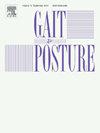经股假体摆动相离地间隙的影响因素-生物力学研究
IF 2.4
3区 医学
Q3 NEUROSCIENCES
引用次数: 0
摘要
背景:经股截肢患者的假体配件在假体侧摆动时应提供足够的离地间隙(GC),以尽量减少绊倒或摔倒的风险。离地间隙不足通常会导致代偿性运动,从而对步态生物力学产生负面影响。研究问题:不同的假体成分和经股假体的对齐如何影响水平行走时假体侧GC和代偿策略?方法选取8例经股骨截肢患者。研究了三个不同的膝关节(一个单中心和两个多中心)以及两个假脚(有和没有被动背屈)。对于假体对齐,膝关节和足的俯仰位置以及假体长度是不同的。利用12摄像头光电系统和嵌入在12米通道中的两个测力板记录运动学和动力学参数。测量在水平行走时进行,自行选择慢、中、快步态速度。结果观察到几个一致的效果。GC随假体摆动膝关节屈曲角度、膝关节前侧位和足部后侧位增加而增加。与多中心膝关节的几何缩短效应相比,单个关节摆动相位控制对GC的影响更大。被动的踝关节背屈增强了GC,但脚的更前位(制造商推荐)消除了这种影响。假体缩短对GC的影响不一致,但对骨盆和躯干产生负面影响。为了弥补GC的不足,主要观察了拱形。研究结果为专家提供了影响离地间隙的相关因素的全面概述。假体对齐和假体膝关节摆动相位控制的重要性尤为明显。这可以帮助优化假肢适合用户的需要,并减少不自然的补偿策略。本文章由计算机程序翻译,如有差异,请以英文原文为准。
Influencing factors on swing phase ground clearance in transfemoral prostheses – A biomechanical study
Background
Prosthetic fittings for persons with a transfemoral amputation should provide adequate ground clearance (GC) during prosthetic side swing to minimize the risk of stumbling or falling. Insufficient ground clearance often leads to compensatory movements that consequently influence gait biomechanics negatively.
Research question
How do different prosthetic components and alignment of a transfemoral prosthesis affect prosthetic side GC and compensatory strategies during level walking?
Methods
Eight persons with transfemoral amputation were enrolled. Three different knee joints (one monocentric and two polycentric) as well as two prosthetic feet (with and without passive dorsiflexion) were investigated. For prosthetic alignment, ap-position of the knee and foot as well as prosthesis length were varied. Kinematic and kinetic parameters were recorded with a 12-camera optoelectronic system and two force plates embedded in a 12-m walkway. The measurements were performed during level walking with self-selected slow, mid and fast gait speed.
Results
Several consistent effects were observed. GC increased with higher prosthetic swing knee flexion angle, a more anterior knee position and more posterior foot position. The individual swing phase control of the investigated knee joints showed a higher impact on GC than by geometric shortening effects of the polycentric knee joints. Passive ankle dorsiflexion enhanced GC, but the more anterior position of the foot (recommended by the manufacturer) eliminates this effect. Shortening of the prosthesis did not affect GC consistently but resulted in negative impact on the pelvis and trunk. To compensate for a lack of GC, vaulting was primarily observed.
Significance
The findings provide experts with a comprehensive overview of relevant factors influencing ground clearance. The importance of prosthetic alignment and prosthetic knee swing phase control was particularly evident. This can help to optimize the prosthetic fitting to the needs of the user and to reduce unnatural compensatory strategies.
求助全文
通过发布文献求助,成功后即可免费获取论文全文。
去求助
来源期刊

Gait & posture
医学-神经科学
CiteScore
4.70
自引率
12.50%
发文量
616
审稿时长
6 months
期刊介绍:
Gait & Posture is a vehicle for the publication of up-to-date basic and clinical research on all aspects of locomotion and balance.
The topics covered include: Techniques for the measurement of gait and posture, and the standardization of results presentation; Studies of normal and pathological gait; Treatment of gait and postural abnormalities; Biomechanical and theoretical approaches to gait and posture; Mathematical models of joint and muscle mechanics; Neurological and musculoskeletal function in gait and posture; The evolution of upright posture and bipedal locomotion; Adaptations of carrying loads, walking on uneven surfaces, climbing stairs etc; spinal biomechanics only if they are directly related to gait and/or posture and are of general interest to our readers; The effect of aging and development on gait and posture; Psychological and cultural aspects of gait; Patient education.
 求助内容:
求助内容: 应助结果提醒方式:
应助结果提醒方式:


